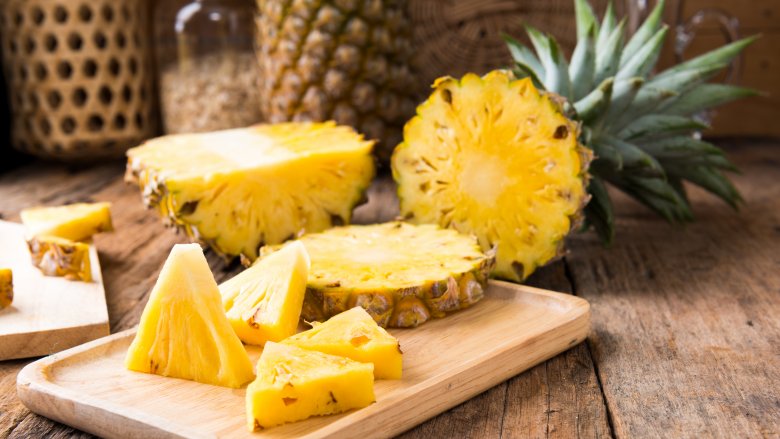How To Tell If A Pineapple Is Ripe
Delicious pineapples — whether blended into a cocktail or served with ham on your favorite pizza — are a treat to eat, but it can be tricky to pick out the perfect specimen without slicing into it. It's important to be able to tell if a pineapple is ripe at the store, because after they're picked, they don't ripen any further (via University of Nebraska-Lincoln). That means that if you take home an underripe pineapple, that's pretty much what you're stuck with. Thankfully, there is a way to tell if the (pine)apple of your eye is ready to eat.
First, you can rely on visual cues. A ripe pineapple will typically be a yellow-gold color, from the bottom to the top. If it's still green or really light yellow, it's likely a little underripe. Pineapples that are more deep orange than yellow might be overripe (via Bon Appetit). Another visual cue is that the leaves on top should be green and fresh-looking, but it's a myth that you should be able to pull leaves easily from a pineapple crown when it's ripe (via Dole).
Second, take a sniff of the stem end. A ripe fruit should be fragrant, with a fresh tropical pineapple scent. If your pineapple smells too deeply sweet, or if the scent has an edge of fermentation or sourness, it's probably overripe and heading towards rot (via Hawaiian Crown).
Lastly, use your sense of touch. A ripe pineapple should be mostly firm, but when you push on it the fruit should yield slightly to your touch, especially around the stem end (pineapples ripen from the bottom up). If the pineapple you're holding is too soft, or if it's rock hard, you should skip it (via The New York Times).
Once you bring your pineapple home, you should eat it as soon as possible, on its own, in smoothies, or in your favorite tropical recipe. Store your pineapple on the top shelf of your refrigerator if you can't eat it right away, but don't leave it for too long — the extended exposure to cold can make the pineapple water-logged.
